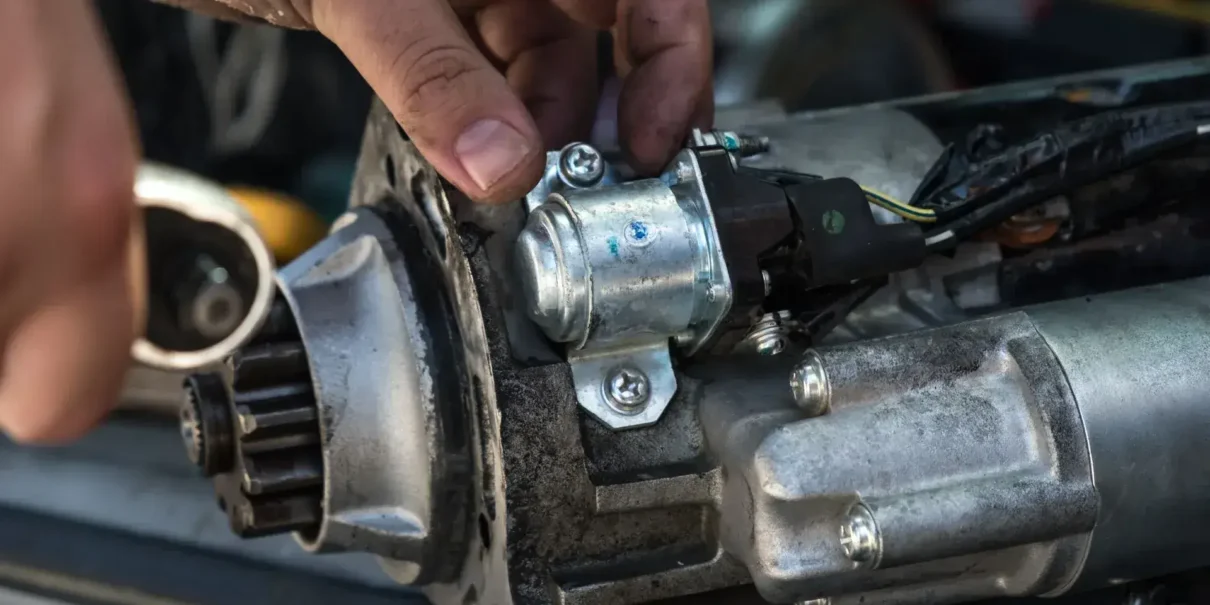The starter motor is one of the most vital components of your car’s ignition system. When you turn the key or press the start button, it converts electrical energy from the battery into mechanical energy, turning the engine’s flywheel to start combustion.
If your car refuses to start, even with a charged battery the starter motor may be the culprit. Understanding how to test a starter motor helps you diagnose issues accurately and avoid unnecessary replacement costs.
What Is a Starter Motor?
A starter motor is an electric motor that engages the engine flywheel to begin the internal combustion process.
It’s typically located near the bottom of the engine and consists of:
- Armature: Rotates when current passes through.
- Solenoid: Acts as an electric switch, engaging the pinion gear.
- Pinion Gear: Connects the starter motor to the flywheel.
- Brushes and Commutator: Transfer current to the armature.
When functioning properly, the starter motor turns the engine fast enough for air and fuel to begin ignition through the spark plugs.
How Does a Starter Motor Work?
Here’s a simple breakdown of the process:
- You turn the key or press the start button.
- The ignition switch sends power from the battery to the starter solenoid.
- The solenoid pushes the pinion gear into the flywheel.
- The motor spins, cranking the engine until it starts.
- Once the engine fires, the pinion gear disengages automatically.
If any of these steps fail — weak current, faulty solenoid, or worn gear — the engine won’t start.
Common Symptoms or Signs of Starter Motor Problems
Before testing, look out for these warning signs that your starter motor may be failing:
- Clicking Noise: A rapid click when turning the key, often caused by a weak solenoid or poor battery connection.
- No Crank or No Sound: Indicates complete starter failure or electrical fault.
- Grinding Noise: Worn pinion gear teeth or misaligned flywheel.
- Intermittent Starting: Starter motor engages only sometimes.
- Smoke or Burning Smell: Electrical overload or internal short circuit.
If your headlights stay bright when trying to start, the issue is likely the starter motor, not the battery or alternator.
How to Test a Starter Motor
Testing a starter motor helps confirm whether the issue lies with the motor, battery, or electrical system.
Tools Needed
- Digital multimeter or test light
- Jumper cables
- Wrenches
- Battery charger (optional)
1. Check the Battery First
Many “starter” problems are actually battery-related.
- Use a multimeter to test voltage.
- A healthy battery should read 12.4–12.7 volts when idle.
- If voltage is low, charge or replace the battery before proceeding.
2. Inspect Cables and Connections
Loose or corroded terminals reduce current flow.
- Check both positive and ground cables.
- Clean with sandpaper or a wire brush.
- Ensure tight, corrosion-free connections at the starter motor and battery terminals.
3. Perform a Voltage Drop Test
- Connect the multimeter’s positive lead to the starter’s power terminal, and the negative lead to the starter body.
- Have someone try to start the car.
- If voltage drops below 9.6 volts during cranking, there’s resistance in the cables or the starter motor is drawing too much power.
4. Bench Test the Starter Motor (Off the Vehicle)
If accessible, remove the starter motor and test it directly:
- Secure the starter motor on a flat surface.
- Connect jumper cables:
- Positive to the battery terminal on the starter.
- Negative to the starter body (ground).
- Use a screwdriver to bridge the solenoid terminal to the battery terminal.
If the starter spins rapidly and the pinion gear extends smoothly, it’s functional.
If not, the starter is faulty and should be repaired or replaced.
Starter Motor Replacement Cost in South Africa
Prices vary by car make and engine type, but here’s a general guide:
- Starter motor (new): R1,000 – R3,000
- Reconditioned starter: R700 – R1,500
Related Car Parts and Maintenance Tips
When testing or replacing a starter motor, it’s smart to check:
- Battery terminals and cables – corrosion-free connections are vital.
- Alternator – ensure your charging system maintains correct voltage.
- Ignition coil – weak coils cause incomplete starting.
- Spark plugs – fouled plugs make ignition difficult.
- Flywheel teeth – inspect for wear or damage.
Helpful related guides:
Conclusion: Why Starter Motor Maintenance Matters
A reliable starter motor ensures smooth, quick ignition every time you turn the key. Regular inspections of your electrical system — including the battery, alternator, and wiring — prevent breakdowns and unnecessary replacements.
Testing your starter motor is straightforward with the right tools and basic understanding of the system.
Need a quality starter motor or electrical spares?
Find affordable, genuine auto parts online at car-parts.co.za today.

